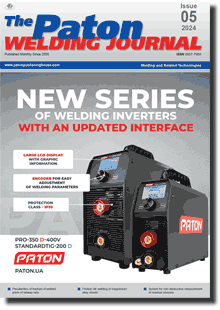| 2024 №05 (02) |
DOI of Article 10.37434/tpwj2024.05.03 |
2024 №05 (04) |

The Paton Welding Journal, 2024, #5, 18-27 pages
18
Consumable and nonconsumable electrode welding of high-strength 2219-T31 aluminium alloy
T.M. Labur, A.G. Poklyatskyi, V.A. Koval
E.O. Paton Electric Welding Institute of the NASU. 11 Kazymyr Malevych Str., 03150, Kyiv, Ukraine. E-mail: pag556a@gmail.comAbstract
The influence of the conditions of consumable (TIG) and nonconsumable (MIG) electrode arc welding of high-strength aluminium alloy of 2219-Т31 grade (USA) 5 mm thick was studied. Effective welding modes were selected by the main characteristics: absence of coarse defects, weld form factor, standard mechanical properties, and features of fracture surface relief. The strength level of welded joints after welding is 25-30% lower compared to base metal (σt=366…370 MPa). The impact toughness values of the welds after TIG welding vary from 16.4 to 20.3 J/cm2, according to the rolling direction. Bend angle is almost 3 times lower than the base metal value (180 and 177 degr.). Fracture of joints with technological reinforcement and of the weld root occurs along the boundary of weld fusion with the base metal, at a distance from the surface along the weld axis. The relief retains a predominantly cellular structure. Analysis results were used to establish the technological conditions of achieving an optimal quality of welds and the type of shielding gas for welding.
Keywords: aluminium alloy, nonconsumable and consumable electrode welding modes, inert gases: argon, helium, welded joints, mechanical properties, investigations
Received: 08.02.2024
Received in revised form: 11.03.2024
Accepted: 23.05.2024
References
1. Beletsky, V.M., Krivov, G.A. (2005) Aluminium alloys (Composition, properties, technology, application). Refer. Book. Ed. by I.N. Fridlyander. Kyiv, Komintekh [in Russian].2. Albert, D. (1993) Aluminium alloys in arc welded constructions. Welding World Magazine, 32(3), 97-114.
3. Ishchenko, A.Ya., Labur, T.M. (2013) Welding of modern aluminium alloy structures. Kyiv, Naukova Dumka [in Russian].
4. Labur, T.M. (2022) Tendencies of technological development of arc welding processes for joining modern aluminium alloys. Svarshchik, 1, 6-17 [in Russian].
5. Lobanov, L.M., Labur, O.P., Mazur, O.A. et al. (2022) Cost optimization of the methods of welding structures of fuel tanks for aerospace vehicles. Avtomatych. Zvar., 3, 42-52 [in Ukrainian]. https://doi.org/10.37434/as2022.03.06
6. Nyrkova, L.I., Labur, T.M., Shevtsov, E.I. et al. (2022) Complex of properties of 2219 alloy weld joint in T62 state under modeling operating conditions. Space Sci. & Technol., 28 (2), 14-29. https://doi.org/10.15407/knit2022.02.014
7. Mashin, V.S., Poklyatsky, A.G., Fedorchuk, V.E. (2005) Mechanical properties of aluminium alloys in consumable and nonconsumable electrode arc welding. The Paton Welding J., 9, 39-45.
8. Kiyoto, S. (1993) Materials and joining technologies for rocket structures. J. of the Japan Welding Society, 62(8), 46-52. https://doi.org/10.2207/qjjws1943.62.630
Suggested Citation
T.M. Labur, A.G. Poklyatskyi, V.A. Koval (2024) Consumable and nonconsumable electrode welding of high-strength 2219-T31 aluminium alloy. The Paton Welding J., 05, 18-27.The cost of subscription/purchase order journals or individual articles
| Journal/Currency | Annual Set | 1 issue printed |
1 issue |
one article |
| TPWJ/USD | 384 $ | 32 $ | 26 $ | 13 $ |
| TPWJ/EUR | 348 € | 29 € | 24 € | 12 € |
| TPWJ/UAH | 7200 UAH | 600 UAH | 600 UAH | 280 UAH |
| AS/UAH | 1800 UAH | 300 UAH | 300 UAH | 150 UAH |
| AS/USD | 192 $ | 32 $ | 26 $ | 13 $ |
| AS/EUR | 180 € | 30 € | 25 € | 12 € |
| SEM/UAH | 1200 UAH | 300 UAH | 300 UAH | 150 UAH |
| SEM/USD | 128 $ | 32 $ | 26 $ | 13 $ |
| SEM/EUR | 120 € | 30 € | 25 € | 12 € |
| TDNK/UAH | 1200 UAH | 300 UAH | 300 UAH | 150 UAH |
| TDNK/USD | 128 $ | 32 $ | 26 $ | 13 $ |
| TDNK/EUR | 120 € | 30 € | 25 € | 15 € |
AS = «Automatic Welding» - 6 issues per year;
TPWJ = «PATON WELDING JOURNAL» - 12 issues per year;
SEM = «Electrometallurgy Today» - 4 issues per year;
TDNK = «Technical Diagnostics and Non-Destructive Testing» - 4 issues per year.


